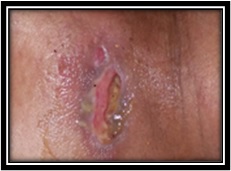A rare complication of ERCP: colocutaneous fistula
Abstract
Endoscopic Retrograde Cholangiopancreatography (ERCP) is the most widely used diagnostic and therapeutic modality for hepatobiliary and pancreatic diseasesbut is not free from complications. Though rare, the common complications are migration of biliary stent, perforation, pancreatitis, hemorrhage, cholangitis, intra-abdominal sepsis, obstruction, etc. Here, we report a rare complication of ERCP presented as colocutaneous fistula. Colocutaneous fistulas are abnormal communications between the colon and the abdominal skin. They can occur spontaneously in patients with inflammatory bowel disease (most common) as well as after an injury or a surgical procedure. About one-third of fistulas close spontaneously with medical treatment and surgery being reserved for failures after optimal medical treatment. This case of colocutaneous fistula following ERCP presented to us was successfully treated as a single staged procedure without any complication. To the best of our knowledge, this is the first case reported of colocutaneous fistula following ERCP.
Downloads
References
Freeman ML. Adverse outcomes of ERCP avoidance and management. GastrointestEndosc Clin N Am. 2003;13(4):775-798.doi: https://doi.org/10.1016/s1052-5157(03)00107-7.
Anderson MA, Fisher L, Jain R, Evans JA, Appalaneni V,Ben-Menachem T, et al. Complications of ERCP. GastrointestEndosc. 2012;75(3):467-473. doi: https://doi.org/10.1016/j.gie.2011.07.010.
Christensen M, Matzen P, Schulze S, Rosenberg J. Complicationsof ERCP: a prospective study. GastrointestEndosc. 2004;60(5):721-731. doi: https://doi.org/10.1016/s0016-5107(04)02169-8.
Berry SM, Fischer JE. Classification and pathophysiology of enterocutaneousfistulas. SurgClin North Am. 1996;76(5):1009-1018. doi: https://doi.org/10.1016/s0039-6109(05)70495-3.
Vezakis A, Fragulidis G, Nastos C, Yiallourou A, Polydorou A, Voros D. Closure of a persistent sphincterotomy-relatedduodenal perforation by placement of a covered self-expandablemetallic biliary stent. World J Gastroenterol. 2011;17(40):4539-4541.doi: https://dx.doi.org/10.3748%2Fwjg.v17.i40.4539.
Draus JM Jr, Huss SA, Harty NJ, Cheadle WG, Larson GM.Enterocutaneous fistula: are treatments improving? Surg. 2006;140(6):570-576.doi: https://doi.org/10.1016/j.surg.2006.07.003.
deWeerd L, Kjaeve J, Aghajani E, Elvenes OP. The sandwich design: a newmethod to close a high output enterocutaneous fistula and an associated abdominal wall defect. Ann Plast Surg. 2007;58(5):580-583. doi: https://doi.org/10.1097/01.sap.0000237643.45125.8b.
Kaushal M, Carlson GL. Management of enterocutaneous fistulas.Clin Colon Rectal Surg. 2004;17(2):79-88. doi: https://doi.org/10.1055/s-2004-828654.
Samad S, Anele C, Akhtar M, Doughan S. Implementing a proformafor multidisciplinary management of an enterocutaneousfistula: a case study. Ostomy Wound Manage. 2015;61(6):46-52.
Lloyd DA, Gabe SM, Windsor AC. Nutrition and management of enterocutaneous fistula. Br J Surg. 2006;93(9):1045-1055. doi: https://doi.org/10.1002/bjs.5396.
Martinez JL, Luque-de-Leon E,Mier J, Blanco-Benavides R, Robledo F. Systematic management of postoperative enterocutaneous fistulas: factors related to outcomes. World J Surg. 2008;32(3):436–443. doi: https://doi.org/10.1007/s00268-007-9304-z.
Campos AC, Andrade DF, Campos GM, Matias JE, Coelho JC. A multivariate model to determine prognostic factors in gastrointestinal fistulas. J Am CollSurg. 1999;188(5):483-490. https://doi.org/10.1016/s1072-7515(99)00038-1.
Erdmann D, Drye C, Heller L, Wong MS, Levin SL. Abdominal walldefect and enterocutaneous fistula treatment with the vacuum assistedclosure (V.A.C.) system. PlastReconstrSurg. 2001;108(7):2066-2068. doi: https://doi.org/10.1097/00006534-200112000-00036.
Evenson AR, Fischer JE. Current management of enterocutaneousfistula. J GastrointestSurg. 2006;10(3):455-464. doi: https://doi.org/10.1016/j.gassur.2005.08.001.
Schecter WP. Management of enterocutaneous fistulas. SurgClinNorth Am. 2011;91(3):481–491. doi: https://doi.org/10.1016/j.suc.2011.02.004.

Copyright (c) 2020 Author (s). Published by Siddharth Health Research and Social Welfare Society

This work is licensed under a Creative Commons Attribution 4.0 International License.


 OAI - Open Archives Initiative
OAI - Open Archives Initiative


















 Therapoid
Therapoid

